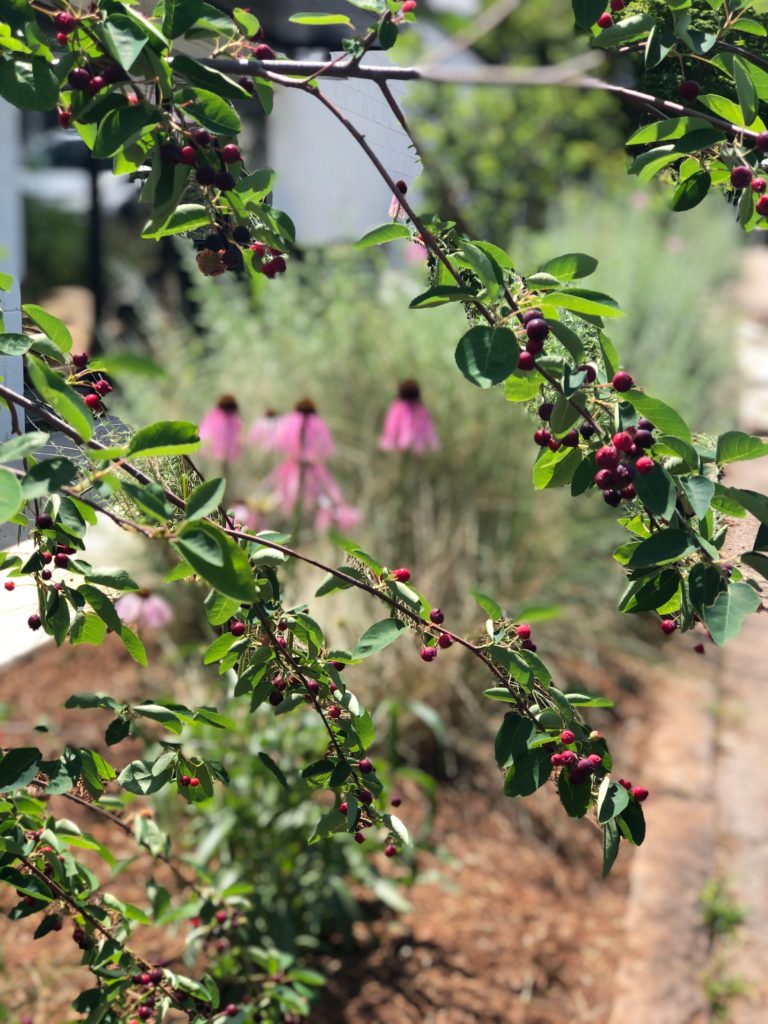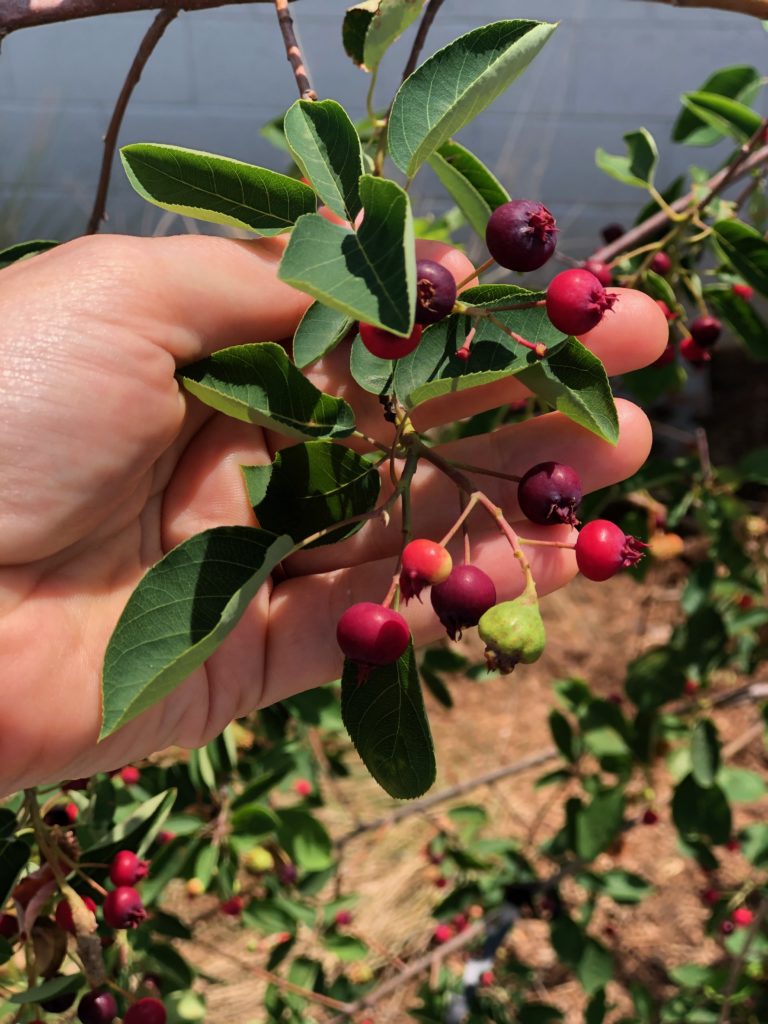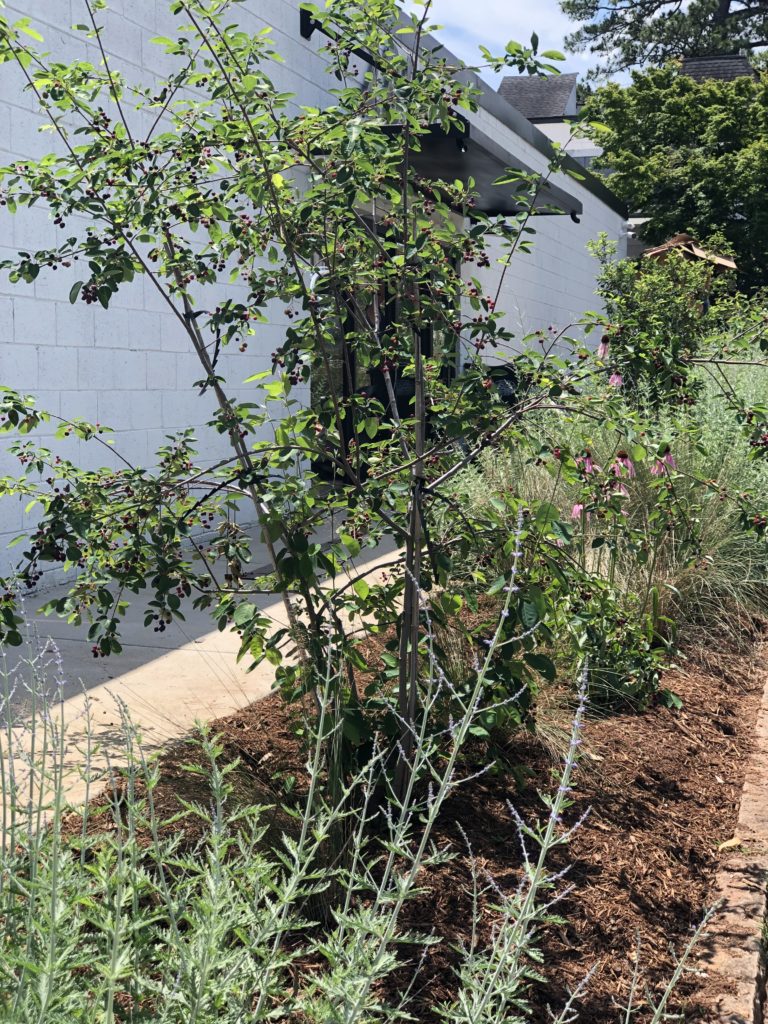In the springtime each year, I take notice of the serviceberry trees that line Atlanta’s streets. It begins with unassuming white flowers, a harbinger of abundance to come, and peaks with baskets full of this incredibly tasty fruit, ripe for the picking. Used prolifically as a street tree, in the dreaded “strip of death” where nothing seems to grow between the sidewalk and road, Serviceberry happily occupies the space without much need for water or anything else and seeds life into our urban landscape. My favorite part of foraging for fruit in our forgotten urban areas, be it Serviceberry or otherwise, is the way I feel feral⏤, a momentary rewilding of sorts. With each handful of fruit in my basket, I awaken from commerce-induced amnesia, and for a moment, I remember that I’m entirely at ease and supported by the earth, everything I need all around me.

A guild of Serviceberry, Russian sage, muhly grass, and echinacea, thriving without irrigation in the strip.
Robin Wall Kimmerer, the author of Braiding Sweetgrass, wrote a remarkable ode to Serviceberry for Emergence Magazine, titled “The Serviceberry: An Economy of Abundance.” Her words explore the ethic of reciprocity and taste like the sweet and tart flavor burst of Serviceberry herself:

“The cool breath of evening slips off the wooded hills, displacing the heat of the day, and with it come the birds, as eager for the cool as I am. They arrive in a flock of calls that sound like laughter, and I have to laugh back with the same delight. They are all around me, Cedar Waxwings and Catbirds and a flash of Bluebird iridescence. I have never felt such a kinship to my namesake, Robin, as in this moment when we are both stuffing our mouths with berries and chortling with happiness. The bushes are laden with fat clusters of red, blue, and wine purple, in every stage of ripeness, so many you can pick them by the handful. I’m glad I have a pail and wonder if the birds will be able to fly with their bellies as full as mine.
This abundance of berries feels like a pure gift from the land. I have not earned, paid for, nor labored for them. There is no mathematics of worthiness that reckons I deserve them in any way. And yet here they are—along with the sun and the air and the birds and the rain, gathering in the towers of cumulonimbi. You could call them natural resources or ecosystem services, but the Robins and I know them as gifts. We both sing gratitude with our mouths full.
Part of my delight comes from their unexpected presence. The local native Serviceberries, Amelanchier Arborea, have small, hard fruits, which tend toward dryness, and only once in a while is there a tree with sweet offerings. The bounty in my bucket is a western species—A. alnifolium, known as Saskatoons—planted by my farmer neighbor, and this is their first bearing year, which they do with an enthusiasm that matches my own.
Saskatoon, Juneberry, Shadbush, Shadblow, Sugarplum, Sarvis, Serviceberry—these are among the many names for Amelanchier. Ethnobotanists know that the more names a plant has, the greater its cultural importance. The tree is beloved for its fruits, for medicinal use, and for the early froth of flowers that whiten woodland edges at the first hint of spring.”
Kimmerer also dives deep into the vital cultural and ecological roles they have played in eastern North America and the lessons they can teach as we reimagine currencies of exchange through the lens of Indigenous wisdom and reciprocity.

And once you read her beautiful essay, you may feel inspired to celebrate Amalanchier spp. And you’re in luck! On Thursday, June 3rd, 2021, the first-ever Serviceberry Fest ATL is happening for precisely this purpose! Join Robby Astrove, Community Farmers Market, and Real Connections for an experience of all things Serviceberry. Sample serviceberry food, treats + libations, listen to a live DJ, and visit our serviceberry tree sale. The East Atlanta Farmer’s Market will complement the festive atmosphere just steps away, so don’t forget your shopping baskets. Sunday, June 6th, in partnership with Community Bucket, Serviceberry Fest ATL gives back with a service project. In service to our local community, proceeds from ticket sales will support a public serviceberry orchard in a local park, school, or public space with the intention that berries will be free and available to the public. The orchard will be planted during the fall of 2021. For more information, and to purchase tickets, visit: https://www.eventbrite.com/e/serviceberry-fest-atl-tickets-150331380205
I hope to see you there!